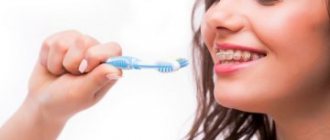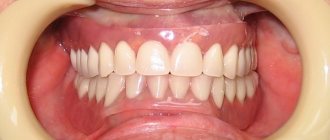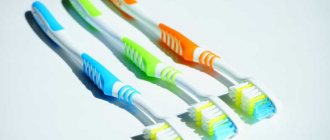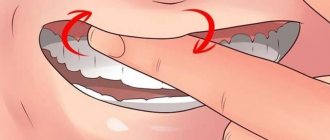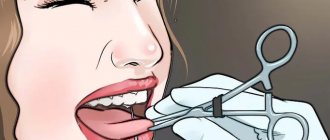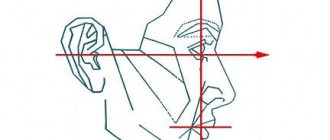The benefits of dental floss
Food particles remain in a person's mouth after every meal.
Without timely removal, they begin to decompose, which leads to an increase in the number of bacteria in the oral cavity. Microorganisms form a soft coating on the enamel. Gradually it hardens and turns into tartar. Hard growths interfere with normal blood circulation in the gums. Inflammation occurs (gingivitis, periodontitis), and bad breath appears. The pathogenic environment promotes the production of organic acids, under the influence of which caries develops. Some pieces of food are gradually decomposed by saliva. The largest particles can be removed by rinsing and brushing. However, plaque and the deepest interdental deposits do not disappear anywhere.
Some people try to clean hard-to-reach crevices with a toothpick, which may have burrs and break. Gums are often injured, but stuck food still remains in place.
For gentle mechanical cleaning of gaps, dentists recommend using dental floss. Another name for the device is floss. Threads are intended for individual use. They are packaged in small boxes and are convenient to carry with you all the time.
Dental floss is used sparingly. The package contains an impressive amount of footage for a modest price. A small length is enough for one session; the remaining length is hygienically hidden inside the container. You can buy floss at any pharmacy or household goods store.
Regular flossing helps:
- normalization of acidity;
- prevention of gum diseases, caries and stones;
- getting rid of bad breath;
- reducing plaque on enamel.
With an integrated approach to teeth cleaning (using a toothbrush, floss, mouthwash), the likelihood of dental ailments is reduced significantly.
Types of dental floss
The prototype of modern floss was an ordinary silk thread. Today, the range of such devices has expanded significantly. On the shelves you can find threads for different anatomical features, from different materials.
The cross-section of the threads is:
- Flat. Designed for patients with very tight fitting teeth. Such a sample easily passes into the interdental space along the entire plane of the tooth.
- Round. Suitable for large gaps between teeth.
- Tape. For wide spaces, gaps in the dental row (three, diastema).
- Volumetric. For any intervals. Swells under the influence of saliva and adapts to individual characteristics. Recommended with uneven interdental distances.
Depending on the type of processing, threads can be waxed or unwaxed. The first ones are covered with wax. Good for children and beginners, as they glide easier and reduce the risk of injury, and do not cause friction on fillings. During use, unwaxed threads are divided into fibers, due to which they cover the entire surface of the tooth. They cope well with plaque.
Flosses can be made from natural and synthetic materials. Natural silk eliminates the risk of allergies, but is fragile. Acetate, nylon and nylon, which are synthetic varieties, provide strength, are inexpensive, but have a less pleasant texture.
Teflon fiber is more expensive than others, but it is the most durable and pleasant to the touch.
Dental floss can have different impregnations:
- No impregnation. Has no properties other than cleansing.
- Sodium fluoride. Used as a caries prevention.
- Menthol. Freshens breath.
- Chlorhexidine. Destroys infectious agents.
- Coal. Sometimes you can find black dental floss on sale. This color is obtained by processing charcoal or bamboo. It is believed that this coating effectively removes heavy plaque and slightly whitens teeth.
According to their design, flosses are divided into:
- Threads in a box. It is necessary to tear off the desired length.
- Flosser brushes. They are a ready-made device made from a small piece of dental floss and a plastic handle.
Recommendations
You can increase the effectiveness of this procedure if you follow certain recommendations:
- It is most convenient to cleanse in front of a mirror . This way you can track every movement and direction of the thread.
- Before using floss, it is recommended to clean with a special orthodontic brush .
Its bristles have a V-shaped cut, where the short central bristles efficiently process the surface of the braces, while the long outer bristles remove plaque from the enamel. - When pulling the floss under the arc, you should try not to touch its surface , as the fibers can catch on the structure and lead to its deformation or breakage.
- It should be borne in mind that the cleaning procedure with braces will be much longer than without them.
- To make it easier to position the floss under the orthodontic appliance, It is recommended to use a special device - a dental floss threader.
It is a small plastic structure that looks like a needle.During use, the tip of the floss is inserted into the eye of the threader, in the same way as a regular thread is inserted into a sewing needle. Then, the threader is pushed under the wire arch of the bracket system, while simultaneously pulling the floss under it.
After this, the thread is released from the auxiliary device and cleaned in a standard manner. The threader is used to clean each segment. This will speed up the procedure and more accurately position the floss.
- During the procedure, do not put too much pressure on the surface of the tooth when removing plaque, as this can damage the enamel.
- If, after the first application of floss, small drops of blood appear on the gums without painful manifestations, do not panic .
After a few days of daily use, gum bleeding will stop. If this does not happen, and the gums continue to bleed, you need to seek help from a dentist. - If a child wears braces, then cleaning should take place under the supervision of the parents . For young children, it is advisable for parents to thread the thread under the orthodontic structure themselves.
Which irrigator for braces should you choose for quality care?
Detailed description of dentin dysplasia.
Let's discuss the Mershona apparatus https://orto-info.ru/sistemyi-vyiravnivaniya-zubov/lechebno-profilakticheskie-apparatyi/mershona.html via the link.
Which thread to choose
You can buy the right dental floss only after consulting a dentist. The specialist will examine the condition of the oral cavity, determine the advisability of using floss at the moment and select the desired type.
When making your own choice, it is worth remembering a few nuances:
- Flosses with antiseptic impregnations are not suitable for children; they are not used for regular use.
- Aromatic impregnations can cause allergic reactions.
- Flossers with handles are more convenient if the head is flexible or floating. This design can be easily adjusted to the structure of a specific jaw.
- Softer threads are more difficult to cut the gums.
- The “superfloss” type combines fibers from different materials. During application, an expanding piece of thread envelops the tooth from all sides, treating it in full. This type is optimal in the presence of microstructures (crowns, dentures, splinting, braces).
- The longer the skein, the longer one box will last. The best option is a floss of 25 m.
- Some brands offer satin-coated threads. They have a softness similar to silk, but are made from durable synthetics (for example, Oral-B).
The required cross-section will have to be determined experimentally without the advice of a specialist.
Types of floss by type
Dental floss can be different, so you need to choose the right design. It is important to understand how this remedy is selected. Today there are 2 types of floss:
- waxed. It is prescribed to people who are encountering this type of cleansing for the first time. Floss of this type will not harm the mucous membranes or gums, because there is a wax coating. It may break;
- unwaxed. They are more effective because they delaminate into individual fibers. This promotes better penetration and contact with surfaces that are contaminated.
How to use it correctly
To see the results from using floss, you need to be able to properly clean interdental spaces with it. The use of floss has general principles, but differs somewhat depending on the situation (age of the user, type of thread, presence of structures in the mouth).
Using waxed and unwaxed floss
Waxed floss is recommended to be used after each meal (before brushing with toothpaste).
Unwaxed floss is more aggressive and should not be used more than 1-2 times a day. They can be used to complete or begin oral hygiene. Before getting acquainted with the unwaxed types, it is advisable to get your hands on the waxed ones.
Use by adults
The cleaning algorithm for an adult consists of the following points:
- Hygiene. Wash your hands well to protect your mouth from excess dirt.
- Preparing the thread. Tear a 25-40 cm piece of floss from the spool and wrap the ends around your middle or index finger. It is more convenient to do this when one hand holds the thread motionless, and the other winds the free end around itself. It is important not to squeeze the skin or cut it. The working gap should be left from 4 to 6 cm.
- Beginning of work. Stretch the section well between your fingers, open your mouth, and with a gentle movement, without pressing on the gum, insert the thread into the first gap.
- Cleaning. Gently move the floss back and forth, and then up and down, pressing it against the side of the tooth. Move sequentially into each gap. Walk from bottom to top along the front and back of the teeth. Treat the entire upper and lower jaw. From each angle, 6-7 movements are enough. The thread is brought to the gum and placed slightly under it. In this case, you should not jerk your hands sharply, so as not to damage the delicate tissue. In the process of changing the gap, it is necessary to unwind a fresh segment. The used fragment is wound onto one of the fingers.
- End of cleaning. Remove floss from mouth. Rinse the cavity with dental solution and spit.
It is not advisable to use raw water for rinsing, as there is a risk of introducing bacteria into the oral cavity.
Use by children
The cleaning principle is the same as in the case of adults. However, dentists recommend that children under 10 years of age carry out manipulations with the help of their parents. The first few times, mom or dad can do the procedure entirely with their own hands. When the child understands the nuances, you can give him the thread, but observe and control the process.
Children are especially susceptible to tooth decay, so it is advisable for them to floss after every meal.
In the presence of microstructures
When wearing braces, crowns and other devices, especially many pieces of food accumulate in the mouth. Their removal is required after every meal.
An easily gliding waxed thread is suitable for designs. A length of 25 cm is enough so that the floss does not cling to the metal when cleaning. First, the area under the system is treated, then they move on to the interdental distances.
Brushing your teeth with an electric brush
Electric toothbrushes vibrate and/or rotate to effectively remove plaque and provide a cleaner mouth. If you are wondering what is better to brush your teeth - a regular or an electric brush - then you should give preference to the latter.
But it is important to strictly follow the cleaning rules so that the daily hygiene procedure is effective and safe. We have prepared a small instruction:
- squeeze the paste onto the brush and press the power button;
- hold the brush at a 45 degree angle;
- Move the brush along the front surface of your teeth, pausing for a few seconds on each one. Typically the head size is sufficient to clean one tooth;
- repeat the manipulations along the inner surface of the teeth;
- complete the procedure by cleaning the chewing surfaces of the teeth.
Important: there is no need to put extra effort or pressure on the brush. Direct it, and the movable head will handle the task itself. Some models of electric brushes are equipped with pressure sensors and will warn you if there is excessive pressure.
Contraindications to the use of threads
Dentists prohibit the use of floss during inflammatory processes on the oral mucosa. Active periodontal disease, gingivitis and stomatitis require preliminary therapy. Only after healing can the doctor allow flossing.
The main damage is caused by incorrect application technique. Aggressive movements can injure the gums, cheeks, and tongue. An infection can get into the wounds, causing inflammation and bleeding. Permanent injury can lead to tooth loss. Therefore, if in doubt or after unsuccessful attempts to use floss, you should contact your dentist for help.

